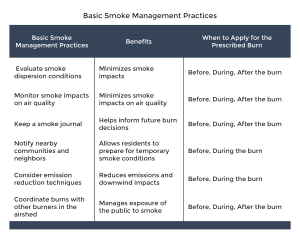Prescribed fire is a planned and controlled fire designed to reduce hazardous fuel loads or to manage or restore natural landscapes. To minimize smoke impacts, each prescribed fire plan considers the burn location, fuel load, moisture, and weather conditions under which the burn will be controlled.
Like all outdoor burning, prescribed fires produce smoke, which can pose a health risk if not managed properly. Limiting smoke impacts from prescribed fire is critical in protecting air quality and human health.
An effective smoke management program allows for prescribed fire to occur while meeting the National Ambient Air Quality Standards (NAAQS). DEQ’s smoke management program is being developed through current rulemaking efforts to comply with the health-based NAAQS.
This accordion will not appear on the screen
Idaho has delegated authority by the Clean Air Act to issue air quality permits and enforce air quality regulations. States with this authority are required to develop plans demonstrating how they will achieve and maintain the NAAQS.
Idaho’s existing prescribed fire rule (IDAPA 58.01.01.614) requires DEQ to develop a smoke management plan for prescribed fire. DEQ is working with local, state, and federal agencies, private forest owners, logging contractors, industry, conservation groups, health organizations, and tribal leaders to develop a statewide smoke management program.
Use this link to view the materials the agencies have developed to share the proposed smoke management plan.
The Idaho Department of Lands (IDL) is responsible for forest practices including fire prevention, fire mitigation, and fire suppression. Forest operations, such as harvesting, thinning, and slash burning, could require compliance/notification to IDL. Burning must be planned and executed in a way that protects forest resources and meets air quality standards.
Many large land managers including state, federal, and large industrial forest owners in Idaho belong to the Montana/Idaho Airshed Group. This group was formed to limit the impacts of smoke generated from forest and rangeland burning conducted by its members.
During the spring and fall prescribed fire seasons, DEQ coordinates daily with the Montana/Idaho Airshed Group to develop a daily burn decision based on current and forecasted air quality and weather conditions. Members are required to follow the daily burn decision.
To see proposed and approved prescribed burns for members of the airshed group go to:
The use of basic smoke management practices can help avoid smoke impacts on public health during prescribed burns, which includes slash pile burning. For more information on basic smoke management practices, see the Natural Resources Conservation Service’s Basic Smoke Management Practices Technical Note.
Click on the image to enlarge.
Forecasting air quality and weather is critical to supporting prescribed fire decisions. DEQ develops a daily air quality and smoke management forecast and monitors air quality and weather conditions to help evaluate whether prescribed burning decisions protect public health. Below are several links for weather and air quality information in your area.
- Air quality forecast for your area.
- Verify outdoor burning is allowed in your area.
- Check the National Weather Service for your forecast.
- Review the crop residue burning smoke management forecast for your area.
Always check with your local fire protection district or the local fire department prior to burning. A fire safety permit from your local fire department or the Idaho Department of Lands may be required. Fire safety concerns may prohibit open burning.
Fire safety permit holders must comply with DEQ rules and any local ordinances and are never allowed to burn prohibited materials or burn if a burn ban is in effect.


